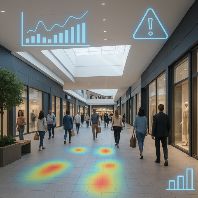COVID-19 changed the market in unprecedented ways in the past year. The health crisis was closely followed by the whole industry throughout 2020. Stores were forced to close, employees were furloughed or laid off, supply chains were strained. Headed into 2021, the pandemic is still very much present and will continue to shape the year ahead. Indeed, the ability of the crisis to cause more problems, depending on how the world recovers will have the largest effect on the industry this year.
The dramatic shift toward e-commerce has undoubtedly altered consumer behaviors in the past several years alone, but the impact of COVID-19 lockdowns, travel restrictions, and social distancing have accelerated an even greater systemic change. The convenience of click and ship with zero health risks will continue to drive people to shop online, and for those that do leverage a storefront, Buy-Online-Pickup-in-Store and curbside pickup will be the preferred method for many. Following an exceptional take-up rate for online shopping in 2020, consumers are eager to make even more of their food purchases online in 2021. According to the research by McKinsey, 25% of consumers who already bought online at least occasionally want to increase their online purchasing even further. The more often consumers bought online in 2020, the more likely they seem to be to increase their share of online buying.
Given the situation, enticing consumers to return to in-store shopping will be challenging, and unpredictable store operating hours and traffic in the first half of 2021 will make it more difficult for retailers. Retail real estate will need to further adapt to these changes, and brands will need to reevaluate physical footprints.
1. The pandemic has forever changed the brick-and-mortar landscape
2020 followed by 2021 have seen an unprecedented number of bankruptcies filed from the major retail players worldwide. Companies such as Gap Inc., Macy's, Victoria's Secret, to name but a few, announced plans to close doors permanently, adding up to hundreds of empty locations. In contrast, shop owners who opted to launch their store as a pop-up late last year have suffered fewer consequences following the lockdown measures. This is largely due to an ability to avoid losses because of the shorter lease commitments, and a chance to amend their strategy according to the new rules. Moreover, the public health crisis accelerated a change in consumer’s investment in the person or story behind a product. Campaigns to shop locally and support independent retailers shifted the community's focus towards independent brands, creating a greater incentive for retailers to experiment with a pop-up format.
2. New wave of pop-up mania
Inspite of the rapid rise of etail, analytics maintain that physical presence will remain crusial for many retailers. In light the ever changing public health sutatuon and the need to quickly adapt to new rules imposed to curb the spread of the virus, the fashionable pop-up stores are predicted to be a key to generating greater sales and brand loyalty. Prior the pandemic, the fashionable trend was utlized to test out novel and frquently risky ventures, temporarily show off a line or a product by creating greater publicity buzz to surge the sales. With the vaccine rolls out and a plenty of vacant space to make a use of, we might just have a pop-up summer ahead of us. Some big-name brands have already looked to pop-ups as a way to attract more customers. Stella McCartney has lanched a pop-up to the lifting of restrictions for retailers in the UK, Guess is about to open its first pop-up store in Germany for Activewear. Camille Walala has turned the London Design Museum's shop into a pop-up supermarket selling artist-designed foods. Other notable names who launched pop-ups following the latest changes to lockdown rules worldwide include Paul Smith, Burberry, L'Estrange, Isabel Manns and Taylor Yates.
3. E-tail giants consolidated their positions
Walmart, Amazon, Target and Costco all saw growth last year ranging from very solid to explosive. Each of them got there in different ways and for different reasons, but those companies have a few things in common. They are huge, with vast cash and capital resources to invest in their businesses and capabilities. And all four are generalists to varying degrees. Along with leaning on Amazon's super fast delivery, pandemic-wary shoppers in 2020 flocked to the one-stop big-box sellers like never before. Their broad offerings meant customers could reduce their trips and, with them, their potential virus exposure. That had the effect of accelerating a longstanding trend of consumers 'ditching specialists' for generalists as a matter of convenience and price. Walmart and Target have also made deep investments in their omnichannel capabilities and product offering that were paying off just as the pandemic shifted shopping habits. The question hanging over the year ahead is whether retail's biggest players can hold on to customers they gained during the pandemic, or, on the flip side, whether smaller specialists can compete against the retail heavies.
4. Value is king
According to the latest research by McKinsey, CEOs see downtrading, or increased price sensitivity, as the most influential trend for the grocery market, with 56% of CEOs listing it among their top three priorities. The downtrading trend is amplified by an increased quality expectation of consumers at the entry-level price tier (ranked at number seven in the CEO survey), as it puts pressure on grocery retailers regarding both price and quality. The survey confirms this downtrading trend. Across Europe, a net 34% of consumers indicated that they want to save money when shopping in 2021 compared with 2020, 27% plan to research promotions more actively, and 17% want to switch to less-expensive products.
5. Personalizing experiences and aligning with values
As consumer needs continue to shift — and with abundant options at consumers' fingertips, brands need to start rebuilding that loyalty by reinforcing two major influences: consumer trust and confidence. They can accomplish this in a few different ways, including through technology. RFID for instance allows brands to enable real-time inventory at 98%+ and collect data on consumer shopping behaviors (including via smart fitting room solutions) that can help improve the overall shopping experiences. Additionally, QR code offers a way for consumers to learn more about the actual journey of their product, including sourcing and sustainability - which are increasingly important for eco-conscious consumers today. Both options allow brands to improve the foundation of their sales: trust. In order to drive these engaging and memorable moments, immersion and personalization will be key. While in-store shopping may still be limited this year, brand owners can still accomplish this through their website, promotions, and products – down to the very label and tag used — helping consumers to feel unique and individualized. One way brands can do this is by embracing their personalities, giving them the ability to customize products.
6. Sustainable shopping
Moreover, today's shoppers, especially the younger generations, are also increasingly aware of Corporate Social Responsibilities and companies that align with their own values. Fast fashion is declining and quality over quantity is the priority — meaning that brands that are transparent around ethically sourced and sustainable materials, fair factory production conditions, and socially inclusive and responsible efforts will fare that much better with eco-conscious consumers. McKinsey reports that COVID-19 crisis has also accelerated the trend toward more healthy, sustainable, and local products. Across Europe, a net 30% of respondents plan to focus more on healthy eating and nutrition in 2021 compared with 2020, 24% plan to spend more on regional and local products, and 19% plan to spend more on environmentally friendly products. These effects continue to be strongly influenced by individual economic situations.
With the vaccine rollout and gradual return to (new) normal, retailers will face a myriad of challenges, pushing them to explore new strategies to get back on their feet. Between social distancing norms, forcing retailers to limit the number of shoppers present in their stores, and lockdown restrictions, which accelerated consumer reliance on e-tail, the ongoing public health crisis has drastically affected consumer behaviour. Value, greater corporate social responsibility, retailer transparency, and shopping experience have become even more important for consumers, affecting the way they spend. With many industry experts continuing to disagree regarding the possibility of revenge shopping, many agree that innovations in customer service will be a key to helping the brands to stand out. There's no doubt that e-tail giants will continue to consolidate their position, but physical retail is still here to stay. With the commercial real estate opportunities being reevaluated many retailers are expected to follow the pop-up trend banking on consumers' FOMO exacerbated by the prolonged isolation.















